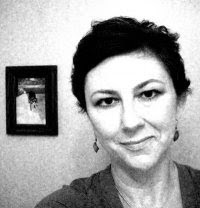We are working with a limited palette: Titanium white, cad yellow med., cad red med. Ultramarine blue, burnt sienna, raw sienna (or yellow ochre) and burnt umber
Step by step example:

Step One: Transparent monochrome
Using burnt sienna (it’s warm and transparent), sketch in the structure of the face and indicate light direction. Don’t worry about details; work from the general at this stage. Your paint should be fairly thin…use a rag to wipe back into it.

Step Two: Lay in shadows. Combine a little burnt umber to your burnt sienna. Paint should be thin, but not watery. Check proportions, redraw if needed. Be sure to also address negative space…remember, you will be creating edges via value and color shifts rather than line…Reminder: shadows are warm

Step Three: Halftone Halftone is cool….I used raw sienna (or yellow ochre), a touch of cad red (or you could use alizarin crimson), a bit of white….then I added just a touch of ultramarine blue to cool it down. What you don’t want to have is green---you’re looking for a neutral that’s a bit cool.
I’m still not too worried about details

Step Four and Five: Light and some details. Light is warm. I mixed a flesh tone that was a bit on the peachy side…same combination as above, but I omitted the blue and added a bit of cad yellow.
Compared to the Rubens portrait on page one, my model’s skin tone is darker and more olive.
At this point, I allow myself to take out a smaller brush, and develop some of the details, such as the eyes. I still keep it loose.

The Final Stage: Highlights and refining. Once I’ve laid in all the basic information (as in steps 1-5), then I mix a very light, slightly cool flesh tone. Remember, white is cool, so if you add quite a bit of white to your paint, it will be cool. But, use highlights sparingly or it will turn your painting "chalky".
I also refine any other areas that need it…if the paint isn’t quite thick enough, or if I need to move a shadow slightly.
I also darken the negative space. I could certainly refine more, but this is all the time I allowed for this sketch.....
Some helpful hints: Don’t try to blend too much. Strokes of varying value and color are far more interesting than continuous tone in a portrait like this. Flesh tone is not a single color you mix up and apply to your canvas…it’s an effect you create by laying related colors side by side. .


No comments:
Post a Comment